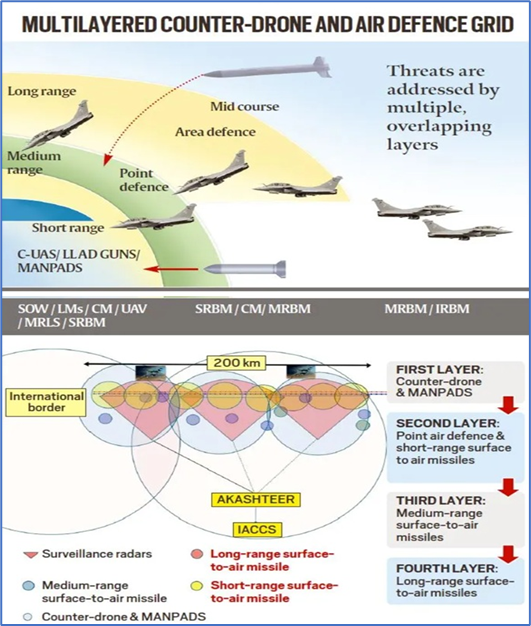Why in News?
During a media briefing on Operation Sindoor, the IAF showcased its Integrated Air Command and Control System (IACCS), which provides a real-time feed of India's air defence operations.
This system integrates radar, control centres, fighter jets, and ground-based defences to protect against aerial threats like enemy aircraft, drones, and missiles.

What’s in Today’s Article?
- The IAF’s Integrated Air Command and Control System (IACCS)
- The Army’s Akashteer System
- Multilayered Air Defence Umbrella
- Future of IACCS
The IAF’s Integrated Air Command and Control System (IACCS)
- IACCS is an automated command and control system developed by Bharat Electronics Limited (BEL) for the Indian Air Force.
- It integrates data from various air defence sources, including ground and airborne radars, civilian radar systems, communication nodes, and command centres.
- Real-Time Situational Awareness
- The system provides real-time updates and a consolidated dataset to commanders at multiple levels.
- This ensures comprehensive situational awareness during air operations and enhances decision-making in response to aerial threats.
- Command Structure and Execution
- IACCS supports central control with decentralised execution, enabling swift identification and response to threats.
- It helps reduce reaction time and allows commanders to deploy air defence assets effectively.
- Enhanced Airspace Management
- Overlapping radar and radio coverage within IACCS ensures efficient airspace monitoring and reduces system redundancy, leading to better coordination and control of air defence operations.
The Army’s Akashteer System
- Akashteer is the Indian Army’s air defence control and reporting system, designed to connect and coordinate its air defence units.
- It enables monitoring of low-level airspace over battle zones and controls ground-based air defence weapon systems.
- Development
- Akashteer has been developed by Bharat Electronics Limited (BEL).
- Integration with IAF Systems
- Currently operating on a smaller scale, Akashteer is being integrated with the Indian Air Force’s IACCS to ensure seamless coordination between Army and Air Force air defence operations.
Multilayered Air Defence Umbrella
- The Indian military employs a multi-layered air defence system, combining various assets to detect and neutralise aerial threats at different ranges and altitudes.
- Key Components
- Point Defence: Includes low-level air defence guns and shoulder-fired weapons.
- Aerial Defence: Comprises fighter aircraft and long-range missiles.
- Surveillance Grid: Utilises ground-based radars and airborne systems like (Airborne Warning and Control System) and AEW&C (Airborne Early Warning & Control) Systems, all integrated into the IACCS for real-time tracking and interception.
- Four Defence Layers Explained
- Layer 1: Counter-drone systems and MANPADS (Man-Portable Air Defence Systems).
- Layer 2: Point air defence and short-range surface-to-air missiles (SR-SAM).
- Layer 3: Medium-range surface-to-air missiles (MR-SAM).
- Layer 4: Long-range surface-to-air missiles (LR-SAM).
Future of IACCS
- Expanded Integration of Defence Assets
- The IAF has bolstered its air defence by deploying more radars and Surface to Air Guided Weapon (SAGW) systems, all integrated into the IACCS network at key sensitive bases.
- Towards Tri-Service Coordination
- With the increasing complexity of modern warfare, IACCS will be pivotal in integrating air defence assets across the Army, Navy, and Air Force for a unified and coordinated response.
- Embracing Advanced Technologies
- Future upgrades to IACCS will incorporate cutting-edge technologies like artificial intelligence for real-time threat analysis and enhanced situational awareness.









